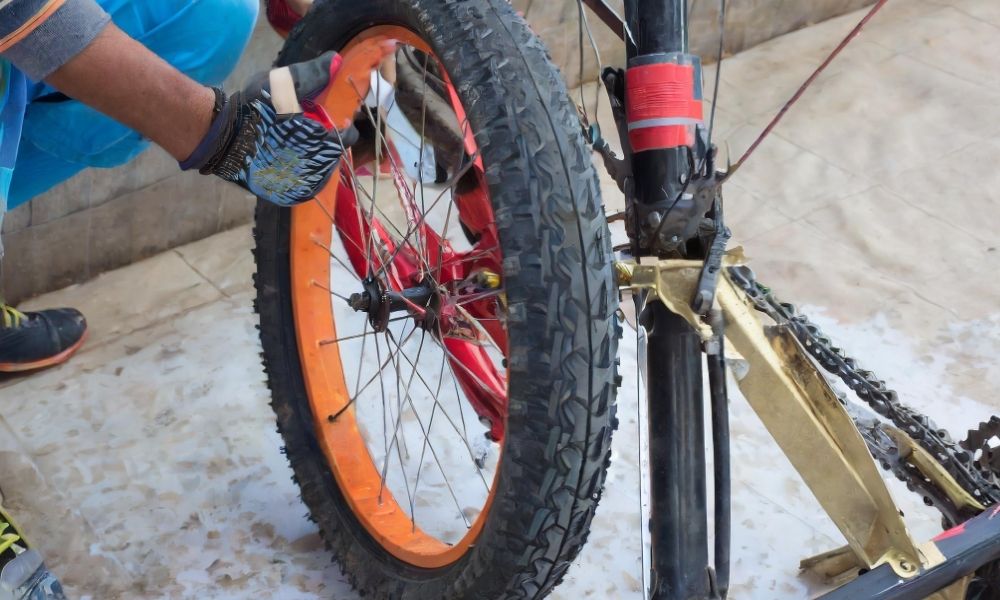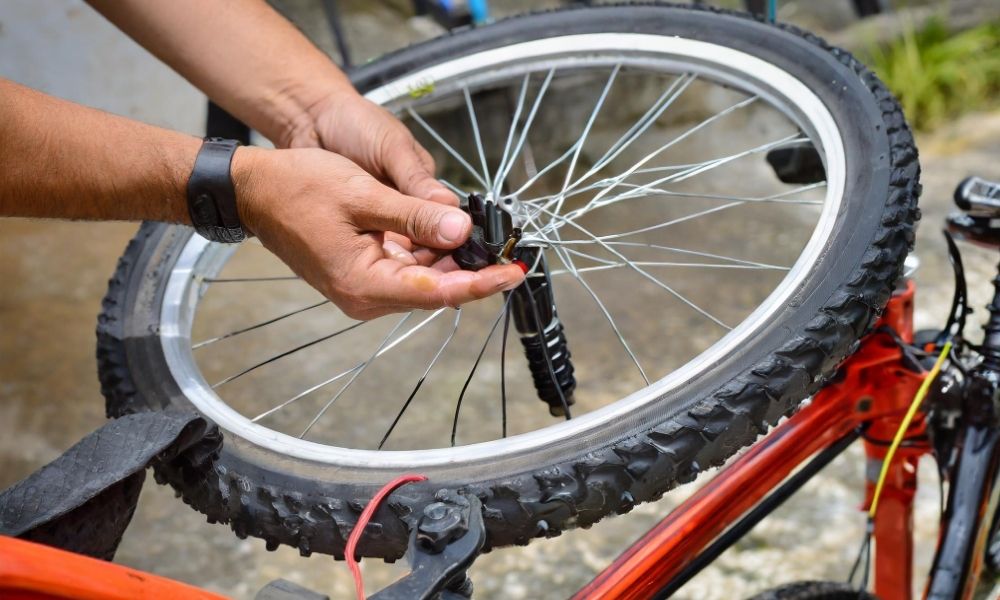Replacing a bicycle tire can cost anywhere from $10 to $60. Bicycle tires can wear out over time due to usage or punctures, requiring replacement.
The cost of replacing a bicycle tire can vary depending on factors such as the type of bike, tire, tire size and quality, additional parts needed, and whether you do it yourself or have a bike shop handle the repair all impact the bottom line.
Typically, a basic bicycle tire can range from $10 to $30, while more specialized or high-performance tires can cost upwards of $60. This article will break down exactly what goes into replacing a bicycle tire, typical price ranges, and tips for saving money. Read on to learn how much it really costs to get back on the road after a flat!
Additionally, labor costs may apply if the tire needs to be installed by a professional. Overall, it is important to consider the quality and purpose of the tire, as well as any additional services required, when determining the cost of replacing a bicycle tire.

Key Takeaways – What Does It Really Cost to Replace a Bike Tire?
Swapping out a damaged or worn bicycle tire costs anywhere from $15 for the most basic inner tube up to $250+ for high-end racing rubber. Expect to spend $30 to $100 for an average tire replacement. But tubeless setups, shop labor, and custom wheel upgrades can multiply that total extensively. Selecting tires fit for purpose and learning some self-sufficiency helps control costs majorly. And remember – regular maintenance prevents prematurely needing new rubber! Take these insights on pricing and maximize your bike’s performance per dollar when new treads are required.
Factors Affecting The Cost
When it comes to replacing a bicycle tire, there are several factors that can affect the overall cost. By understanding these factors, you can make an informed decision and ensure that you are getting the best value for your money. In this section, we will explore the various aspects that influence the cost of replacing a bicycle tire.
Type Of Bicycle Tire
The type of bicycle tire you choose can have a significant impact on the cost of replacement. Different types of tires are designed for specific terrains and purposes. For instance, if you are a mountain biker, you may opt for off-road tires that provide excellent traction on dirt paths and rocky trails. On the other hand, if you prefer road cycling, you might choose slick tires that offer low rolling resistance on pavement. The cost of each type of tire will vary based on its unique features and specifications.
Quality Of Bicycle Tire
The quality of the bicycle tire you select will also contribute to the overall cost. High-quality tires are typically made from durable materials that offer enhanced performance and longevity. These tires are often designed to resist punctures and provide better grip. While they may be more expensive upfront, they can save you money in the long run by reducing the frequency of tire replacements. Conversely, lower-quality tires may have a lower upfront cost but may wear out quickly and require more frequent replacement.
Labor Charges
Labor charges are another factor that can impact the cost of replacing a bicycle tire. If you have the necessary skills and tools, you may be able to replace the tire yourself, saving on labor costs. However, if you are not confident in your abilities or do not have the required tools, you may need to seek professional help. Bicycle shops and mechanics typically charge a fee for their services, and this fee can vary based on location and expertise. Before making a decision, it is essential to consider the cost of labor and weigh it against the convenience and expertise provided by professionals.

Average Cost Of Replacing Bicycle Tires
Replacing bicycle tires can vary in cost depending on factors like the type of tire and where it is purchased. On average, the cost to replace a bicycle tire can range from $20 to $50.
Road Bike Tires
When it comes to road bikes, an average cost of replacing bicycle tires can range from $20 to $60 per tire. The price depends on various factors such as the brand, quality, and type of tire you choose. Generally, high-performance road bike tires tend to be on the pricier side, while basic and entry-level options are more budget-friendly.
Mountain Bike Tires
If you own a mountain bike, you’ll find that replacing the tires might cost you around $30 to $70 per tire. Mountain bike tires come in different variations like tubeless, knobby, and tube-type, each catering to different off-road terrains and riding preferences. The price variation is influenced by the features and durability offered by different tire brands and models.
Hybrid Bike Tires
Hybrid bikes, designed for versatile usage on both roads and light trails, have an average tire replacement cost ranging from $25 to $70 per tire. Hybrid bike tires offer a combination of features from road and mountain bike tires, providing a good balance between efficient rolling on pavement and grip on slightly rough surfaces. The cost of replacement tires for hybrid bikes depends on factors such as tire type, puncture protection, and brand reputation.

How do I know if my bike tire needs to be replaced?
Before looking at prices, the first step is evaluating whether your tires truly need replacement. Here are key signs indicating a tire should be swapped out:
- Visible tire wear or dry cracks in the rubber: If the rubber looks abnormally worn, feels overly dry, cracks visibly, or cords underneath are exposed, the integrity is likely compromised. New tires needed!
- Frequent punctures: Some bad luck with thorns doesn’t always mean new tires. But if you’re flatting every other ride with no clear cause, tires could be weakened or ill-fitting to your rim.
- Reduced braking power: Brake pads gripping smoothly to the rubber is key. If braking feels inconsistent or weak despite adjusting pads, a worn tread could be the culprit.
- Age over 2 years: Bike tires degrade over time even if mileage stays low. Swapping out a pair after 2-3 years ensures you get full safety and performance.
Budgeting for Bike Tire Replacement Costs
Okay, so you’ve determined those tires aren’t up for more miles. How much do replacement road, mountain, hybrid bike tires run? Here is an overview of typical price ranges:
- Basic clincher tires = $15 – $50 per tire
- Performance clincher tires = $50 – $90 per tire
- High-performance clincher tires = $90 – $250+ per tire
- Tubular tires = $100 – $400+ per tire
Additional parts and services, like inner tubes, rim tape or labor fees if installed by a shop, will bump up costs further. Most riders pay between $30 – $100 for your average tire change, but personalized or high-end wheel builds can cost hundreds. When budgeting, consider your bike type and needs. A commute-ready hybrid likely doesn’t demand the priciest tire construction!

What factors can affect the cost of replacing a bicycle tire?
From the tire itself to added fees, what all factors into the bill for a tire replacement? Key elements include:
Tire Size & Type Matters
The tire’s dimensions and design for a certain bike impacts pricing majorly. Road bike tires with skinny 700c dimensions cost less than say, a sturdy 29 x 2.3” mountain bike tire. Specialized sizes for some electric or utility bikes also run higher than standard tire formats. And clincher tires typically cost less than tubulars requiring gluing to the rim bed.
Material & Compound Differences
You get what you pay for with rubber! Budget wire bead tires with basic carbon black rubber will save you bucks over advanced clinchers or tubulars mixing in proprietary silica compounds and layering durable Kevlar beads. Determining riding needs helps choose if premium construction upgrades make sense or if basic suits fine.
Additional Parts Bump Up The Total
Beyond the tire itself comes small but not inconsequential parts needed for many replacements:
- Inner tube = $5 – $25+: Most tire swaps also insert a new tube, adding instant expenses. Premium latex tubes cost more than basic butyl rubber. Sizing charts ensure matching to the tire width too.
- Rim tape = $10 – $25 Reinforcing rim bed where tube rests avoids pesky pinhole leaks.
- Tire levers or glue for tubulars further add small one-time costs during install. It all starts tallying up!
Shop Labor Versus DIY Savings
Capable home mechanics can source good quality tires for under $50 per and install themselves using basic tools like tire levers. Shops average around $20 – $40 per tire in labor fees for installs and wheel truing – costs spared by patient do-it-yourselfers! However for complex wheel builds or tubular gluing, professional mechanic expertise pays off despite higher pricing.

10 Tips for Saving Money on Bicycle Tire Replacement
Want to pare down costs when it’s time to swap your tires? Here are handy tips and tricks:
- Buy tires online through discount retailers – local bike shop markups can be real!
- Choose basic clinchers for non-competitive riding. Fancy compounds matter less for casual usage.
- Buy in pairs for package deals – most discounts come on 2-tire purchases.
- Learn self-installs using tutorial videos to dodge labor fees – just have patience!
- Ask shops about take-off tires: Mechanics often remove near-new tires off upgraded bikes that make great spares for cheap.
- Consider puncture resistant tires – the extra weight carries a price benefit of fewer flats down the line!
- Check clearance sales on last year’s designs for deep discounts at shops or online retailers. Discontinued doesn’t mean ineffective!
- Compare prices across local and online shops. Markups can greatly vary so shop around before pulling trigger the on first option.
- Use tape + sealant for tubeless setups: Avoid inner tubes entirely and use liqud sealant plus rim tape to plug small punctures on the go tubeless! Saves future headaches.
- Learn to patch tubes + tires: Small punctures or snags can often be patched for cheap versus complete tire replacement. DIY patching saves money over the long run!
Taking Precautions To Prolong Tire Lifespan
Instead of solely focusing on cost savings through replacement, it’s also essential to consider ways to prolong the lifespan of your bicycle tires. By taking a few precautions, you can maximize their durability and reduce the frequency of replacements, ultimately saving you money in the long run.
- Regularly check your tire pressure and ensure it’s within the recommended range. Proper inflation not only enhances ride quality but also prevents excessive wear and tear on the tire.
- Maintain a clean and debris-free riding surface. Sharp objects on the road or trail can easily puncture your tires, leading to premature replacements. Keeping an eye out for potential hazards and avoiding them can help extend the life of your tires.
- Consider using tire liners or puncture-resistant tires. These options provide an extra layer of protection against sharp objects and potential flats, reducing the need for tire replacements.
FAQs:
Q: How do I choose good bike tires?
A: When selecting bike tires, consider the terrain you’ll be riding on, the type of bike you have, and your budget. Research different types of tires such as road tires, gravel tires, or mountain bike tires to find the best fit for your needs.
Q: Can I change a bike tire myself?
A: Yes, with the right tools and knowledge, you can change a bike tire yourself. It’s a useful skill for any cyclist to learn, and there are many tutorials available online to guide you through the process.
Q: What are the different types of bike tires available?
A: There are various types of bike tires, including road tires, mountain bike tires, gravel tires, and commuter tires, each designed for specific riding conditions and terrains.
Q: Do I need to replace the inner tube when changing a bike tire?
A: It’s recommended to replace the inner tube when changing a bike tire, as it ensures that the tire is properly inflated and reduces the risk of getting a flat again soon after the replacement.
Conclusion
To sum up, the cost of replacing a bicycle tire will vary depending on factors such as the type of tire, brand, and whether you choose to do it yourself or hire a professional. It is crucial to consider the quality and durability of the replacement tire to ensure a smooth and safe ride.
By taking these factors into account, you can make an informed decision and keep your bike in excellent condition.





Leave a Reply